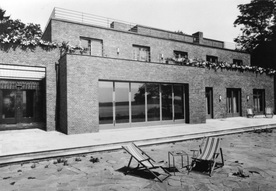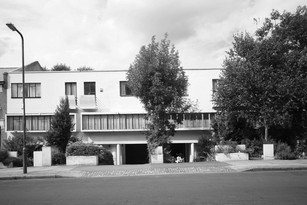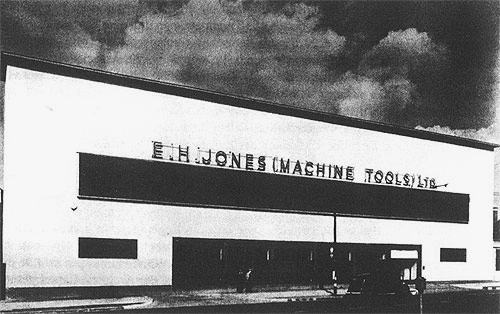|
The birth and spread of modernist architecture in Britain in the 1930's was greatly aided by the large number of emigres from Europe that began arriving from 1933 onwards. These designers; from Germany, Austria, Czechoslovakia, Poland and other European countries; left the continent as Nazism grew in the 1920’s and 30’s. Now iconic architects like Berthold Lubetkin, Walter Gropius and Erno Goldfinger arrived in Britain and began to gradually change the fabric of our cities and towns. Their buildings, such as Trellick Tower, the Finsbury Health Centre and 66 Old Church St, are now emblematic of modernist architecture in Britain. However these famous names are only the most famous names in the flood of architects who fled from continental Europe and made their home and career in Britain. Myra Warhaftig documented 43 of these architects in her Pentagram Papers 37: Forgotten Architects. In this blog we will look at those who settled and worked in Metro-Land. The most famous name of these forgotten architects is Ernst Ludwig Freud (1892-1970). Son of psychoanalyst Sigmund and father of artist Lucian and broadcaster Clement, Ernst was born in Vienna, where he studied architecture before moving to Berlin. He established a practice there, producing a number of surgeries and houses for doctors. He left Berlin in 1933 and settled in St Johns Wood, where Freud made his home and his living. He designed a number of houses and apartment buildings, as well as doing interior work. Frognal Close (1937) was built on the site of Frognal Priory. It is a cul de sac of six semi detached modernist houses in brick. Belvedere Court in Lyttleton Road, East Finchley is a moderne style apartment block, completed in 1938. Intended as rental apartments for Jewish families from Europe, Belvedere Court was designed in three long brick ranges with curved ends. Internally the flats were ultra modern with central heating, fitted kitchens and waste disposal chutes. Freud also designed a number of individual houses including 21 Neville Drive, Hampstead (1935) white walled and flat roofed, in the international style, and flats at 43 Elsworthy Road, Swiss Cottage (1955) in a more austere post war design. Freud worked until 1966 and after his death in 1970 was buried in the family plot in Golders Green Crematorium. Where Freud had a famous name, other architects decided to change their names to fit in in their new environments. Eugen Carl Kaufmann was born in Frankfurt in 1892 and worked in Germany, mainly in regional planning departments. He moved to Britain in 1933, after spending some time in Moscow, changing his name to Eugene Charles Kent. In Britain he joined the MARS group and worked on a number of buildings, designing a factory in Slough (1935) and a one storey, open air section of King Alfred School, Manor Wood (1936), unfortunately now demolished. His main output though was housing. He designed a house for himself in Welwyn Garden City at No. 24 Pentley Park (1938), and designed temporary housing for evacuees for Hertfordshire County Council. Kent also designed a house in Wimbledon in partnership with fellow member of MARS, Elisabeth Benjamin, at 55 Victoria Drive (1935). AV Pilichowski (1907-1982) was another emigre architect who changed his name. Pilichowski, a Polish-Jewish architect, changed his name to Vivien Pilley once in Britain. Pilichowski is mainly remembered for his involvement with two buildings, Highfield Court, a international style apartment block in Golders Green (1935), and 85-91 Genesta Road, Greenwich (1934) with Berthold Lubetkin, a speculative development of four flat roofed modernist houses. Some of the émigrés teamed up in their adopted country. Peter Caspari was born in Germany to well off Jewish parents in 1908 and studied architecture at the Berlin Building College. Caspari and his wife left Germany in 1933, and first settled in London. Here, Caspari produced a number of buildings, with the most notable being the expressionist influenced Kingsley Court apartments in Willesden (1934). He designed a number of other moderne apartment blocks around London, as well as Woodgrange House in Ealing (1950) for government offices. He was briefly in partnership with Hans Sigmund Jaretzki (1809-1956), another Berlin born architect who had fled to London. Together they designed synagogues in Edgware (1955) and Wembley (1956). By the time these buildings were completed Caspari had moved to Toronto, where he became an established part of the Canadian post war architectural scene. The synagogue in Edgware was designed in partnership with engineer Felix Samuely, and is said to have been constructed using some materials from a dismantled Festival of Britain pavilion. Jaretski had designed many buildings in Germany before leaving, including the British Ambassador's residence in Berlin (1932). Another designer of synagogues was Fritz Landauer, who had been practicing in Munich until leaving for Britain in 1933, and designed the Reform Synagogue in Plauen (1928, destroyed 1938). In London he designed a number of synagogues, including the Willesden Green Synagogue (1938) in brick, and with a decorative ironwork grill above the entrance. Landauer also designed the Northwestern Reform Synagogue at Golders Green (1936). Laudauer produced designs for a number of shops, only some of which were built and many not, like his design for Boots in Regent Street (1933). Rudolf Frankel was born in Niesse (now Nysa, Poland) in 1901, and practiced in Berlin until 1933. He fled first to Bucharest then London, where he stayed for 13 years. In this period he built a pair of houses in Stanmore, 1 & 2 Halsbury Close (1938), with Frankel and his family living at No.1. Frankel’s work in Britain centred on the industrial, he designed factories in Wales, Cheshire and London. In 1950 he left Britain to take up the Professorship of Architecture at Miami University. He remained in the US until his death in 1974. These architects didn't go on to become the revered designers that the likes of Lubetkin, Goldfinger, etc did, but they helped embed modernism into the fabric of British towns and cities. They designed the everyday buildings; homes, factories, offices, places of worship,; that make up our environments and helped pave the way for modernism becoming the de facto architectural style in the post war period. They may be largely forgotten today, but their work is still all around us.
References: Pentagram: Forgotten Architects Karlsruher Institute for Technology
1 Comment
|
Archives
May 2024
Categories |





 RSS Feed
RSS Feed